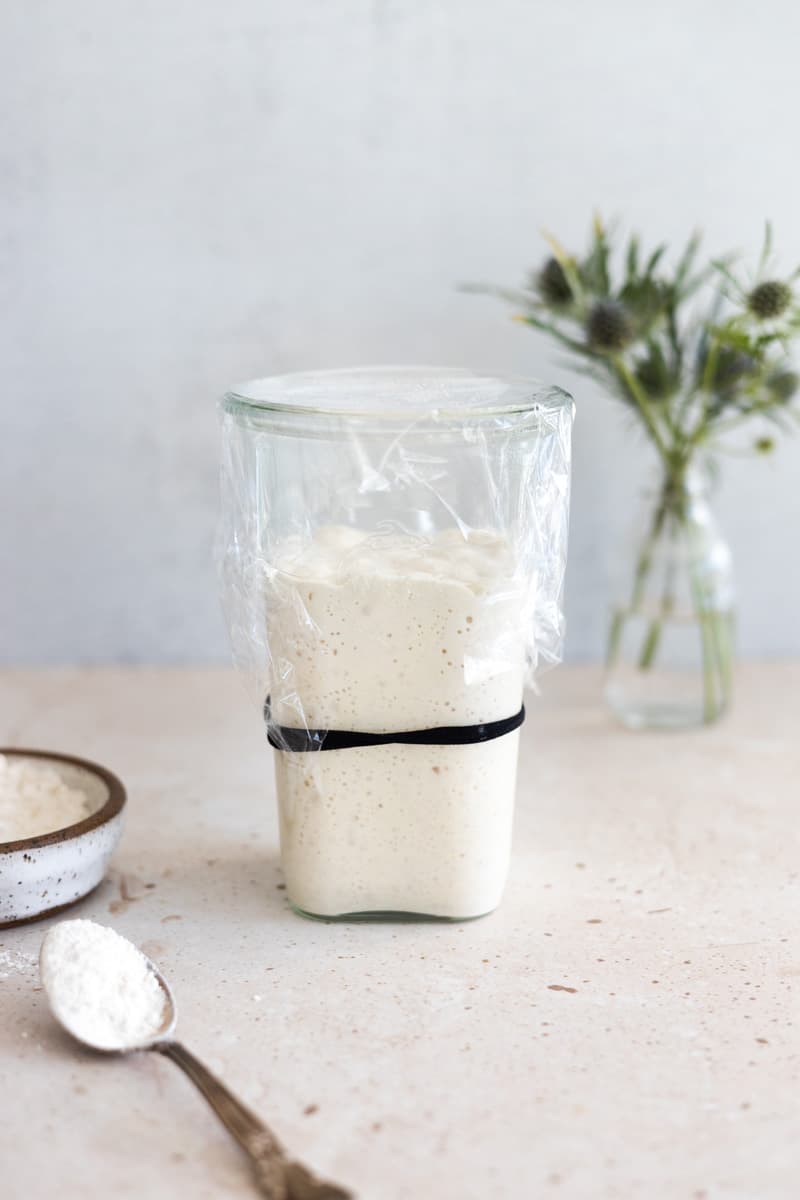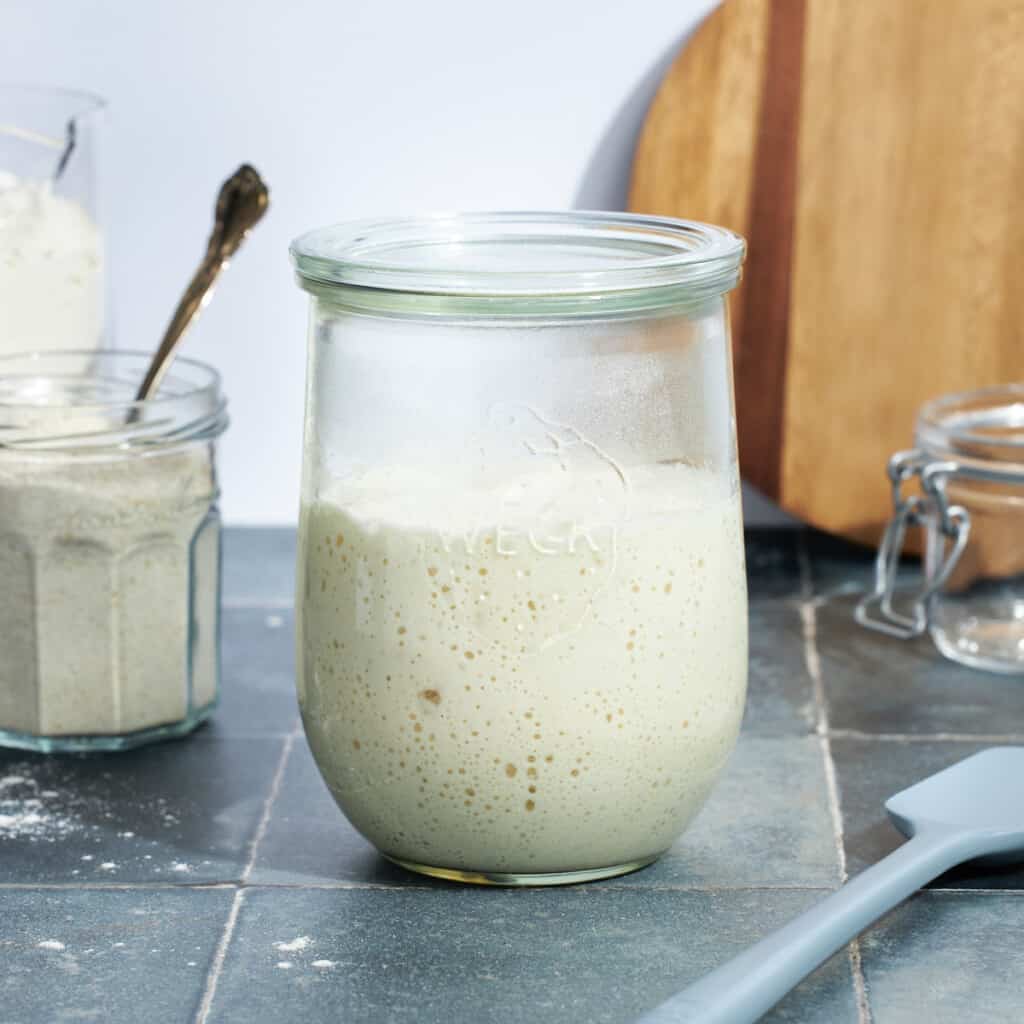If you are having challenges making your own sourdough starter, or your sourdough starter seems to be struggling for some reason, don't give up! Making a healthy and active sourdough starter can take anywhere from 1-3 weeks and varies greatly based on your environment and other factors. In this post, we'll dig into tips for struggling sourdough starter so you can get yours up and running!

If you are going to make changes to how you are feeding or storing your sourdough starter, try them one at a time! Changing too many things at once can make it hard to tell if something has helped or hurt your sourdough starter.
If you're new to the sourdough journey, check out my other in-depth posts on how to feed sourdough starter and how to use sourdough discard.
Jump to:
- How do I know if my sourdough starter is struggling?
- Overactive sourdough starter
- Water Temperature for Sourdough Starter
- Using the correct jar and lid for sourdough starter
- My Favorite Sourdough Starter Jar
- Room Temperature and Sourdough Starter
- Dough Proofing Mats & Seed Sprouting Mats
- Other ways to kickstart sourdough starter
- Sourdough Discard Recipes
- Struggling Sourdough Starter FAQ
How do I know if my sourdough starter is struggling?
Making a sourdough starter from scratch can be a long process, so be patient! Your sourdough starter might be struggling if it's been more than 7 days and:
- You previously saw bubbles and growth, but not anymore.
- There is no activity (no bubbles or growth) with the starter.
- Your sourdough starter is rising, but isn't doubling and doesn't seem to be "getting there."
- Your sourdough starter has grown mold.
If you're on day 2-3 of making a new sourdough starter and aren't seeing much, that's ok! Keep going! Below are a few things to consider if your starter is struggling.
Overactive sourdough starter
A lot of issues comes from sourdough starter not being active enough, but some have the opposite problem: an overactive sourdough starter!
If you like in a humid or very hot environment, your challenges might be slightly different. You might find your starter is growing too quickly (almost out of control), or that it is growing mold very quickly. If those are your issues, your solutions will be more about finding a cooler location and slowing down your sourdough starter, rather than making things warmer and speeding it up.
There are more notes on this in the sections below!

Water Temperature for Sourdough Starter
The first thing to try with a struggling sourdough starter is to make sure you're feeding it with warm water. This water should not be boiling, and you should still be able to put your hand in it, but it should be like a hot shower. This can be a game-changer and you can literally see a different overnight.
If you have an overactive starter and live in a humid or hot environment, this is an area where you can cool things down. If your starter seems to be growing too quickly, use cooler (not cold, but maybe room temperature) water to slow down some of that growth.

Using the correct jar and lid for sourdough starter
Make sure you are using a jar that is large enough to accommodate that starter's growth, but also a lid that allows enough airflow. Your starter should not be in an airtight container. I like to use a Weck Tulip Jar, loosely covered with plastic wrap. This does a few things:
- Allows airflow both in and out of the jar
- Prevents anything from getting into the jar (flies, etc.)
- Keeps the sourdough starter warm and moist
If your sourdough starter is drying out: This means there is too much air getting into the jar. The top of your starter should not appear dry. This can happen if you're using something like a kitchen towel or skewed lid to cover your jar. The starter might also be in a location that is too warm.
If your sourdough starter is too humid: If there is too much moisture trapped in the jar, there is a high risk for mold growth. Try a "lid" or cover that allows for more airflow in and out of the jar. The starter might also be in a location that is too warm.

kitchen essentials
My Favorite Sourdough Starter Jar
The perfect jar for maintaining a sourdough starter!
Room Temperature and Sourdough Starter
Room temperature and environment play a huge role in how active your sourdough starter will be. Even once your starter is up and running, you may notice that it behaves very differently in the summer vs. winter as the room temperature changes. The ideal temperature for a sourdough starter is around 70-80 degrees Fahrenheit. If your house (or room) is warmer or cooler, this could be impacting your starter.
If your starter is struggling to rise, try to move it to a warmer location in your house. A few places that could work:
- On the countertop near the oven: This can often be a warmer spot due to some of the residual heat from the oven. You can also put your jar on a trivet or towel so it's not literally sitting on the countertop (which are often several degrees cooler than the air temperature!).
- Near a sunny window: The starter should not be in direct sunlight, but the area near a sunny window will be warmer!
- In the oven with just the light on: Massive word of caution on this one. If you use your oven often, or you don't look in your oven before you turn it on, this is not going to be a good place for you! If the oven is still warm from something that you baked previously, it will be too warm for your starter.
If you have an overactive starter, your mission will be to find a cooler place for your starter so it slows down a little. Consider trying your pantry, or a room or spot that is less warm.
A lot of this will be trial and error, so test out different locations in your house to see what your sourdough starter likes best!
Dough Proofing Mats & Seed Sprouting Mats
specially if your house is cooler in the winter (mine is!), another option to look into is a dough proofing mat or a seed sprouting mat. This is a mat that warms slightly and is a good way to get your sourdough starter (or dough) off of the cool countertop and warmed just a little bit. A few things to consider here:
- A dough-proofing mat is clearly designed for dough and breads, but they can be pricey (even $100+). A seed sprouting mat (I use the VIVOSUN Seedling Heat Mat) is nearly the same thing and is wildly cheaper (I paid $12 for mine).
- Different mats are going to have different capabilities (sizing, temperature control, top temperature, etc.) so take that into consideration based on your needs.
- Seed sprouting mats come in different sizes, and even wraps that can wrap around your sourdough starter jar.
I like to use my seed sprouting mat for helping dough to rise quicker, but you could also use it to keep your sourdough starter warmer. If you are doing this, keep an eye on the starter to make sure it isn't getting too warm or drying out.
I've also heard of others using similar mats (apparently a reptile mat!) or even a heating pad to warm their sourdough starter. Anything can work, and it's all going to be about trial and error with your starter in your environment!
Other ways to kickstart sourdough starter
If you have tried all of the above things and your sourdough starter still isn't getting there, below are a few other tips:
- At the next feeding, add 1 teaspoon of honey to give the starter some additional sugar to help feed the yeast.
- At the next feeding, use a bit of whole wheat flour (or another whole grain flour) mixed with the all-purpose flour. Try replacing 10-20% of your all-purpose flour with whole grain flour for that feeding. This gives the yeast additional nutrients to feed on.
Sourdough Discard Recipes
As you're working to get your sourdough starter up and running, you will have a lot of sourdough discard. Your options are to either discard it (literally throw it away or compost it), give it to someone to make their own starter, or use it in sourdough discard recipes. You can use the sourdough discard after 7 days of making a new starter (in those early days, you do need to actually discard it).
Below are a few of our favorite sourdough discard recipes, and we're always cooking up more!
Struggling Sourdough Starter FAQ
Liquid that forms on top of sourdough starter (or discard) is called hooch. It may be a bit cloudy or murky, but it's perfectly normal. This is a sign that your sourdough starter is hungry! You can either pour this off, or mix it in the next time you feed your sourdough starter.
Mold in sourdough starter (or discard) can look like traditional green / black / grey fuzzy mold, or it may also present itself as pink or orange spots or streaks. If you see this in your starter or discard at any time, it's time to throw it away and start fresh.
You can either literally discard it (compost or throw it away), you can give it to a neighbor or friend to make their own sourdough starter, or you can use it to make sourdough discard recipes.
You can use sourdough discard after seven days of making a new sourdough starter. In those first initial days, it does actually need to be discarded.









Vanessa says
I am trying to brace myself in the sourdough world, and this is by far one of the best sites I’ve come across from. The quality and quantity of information consolidated it’s incredible. I was a little off by the fact that I would have to “throw the discard”, but now that I know I can actually use it in other recipes I am thrilled. Not to mention all the tips and concepts to understand the science behind sourdough. Now, this is the second article I read in this site, I am looking forward to get into all those recipes tho.
Jessica Vogl says
I'm so glad this was helpful! Sourdough can seem really complicated and intimidating, but it doesn't need to be. And I agree - it seemed so wasteful to get rid of so much discard (that you've just spent literally weeks making), which is why I focus on so many discard recipes!